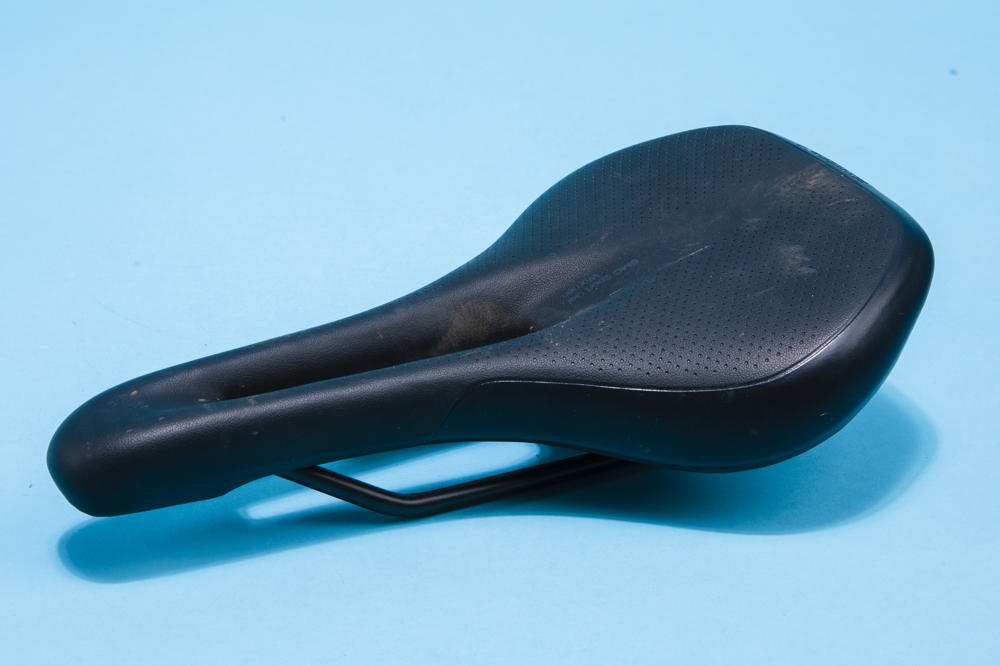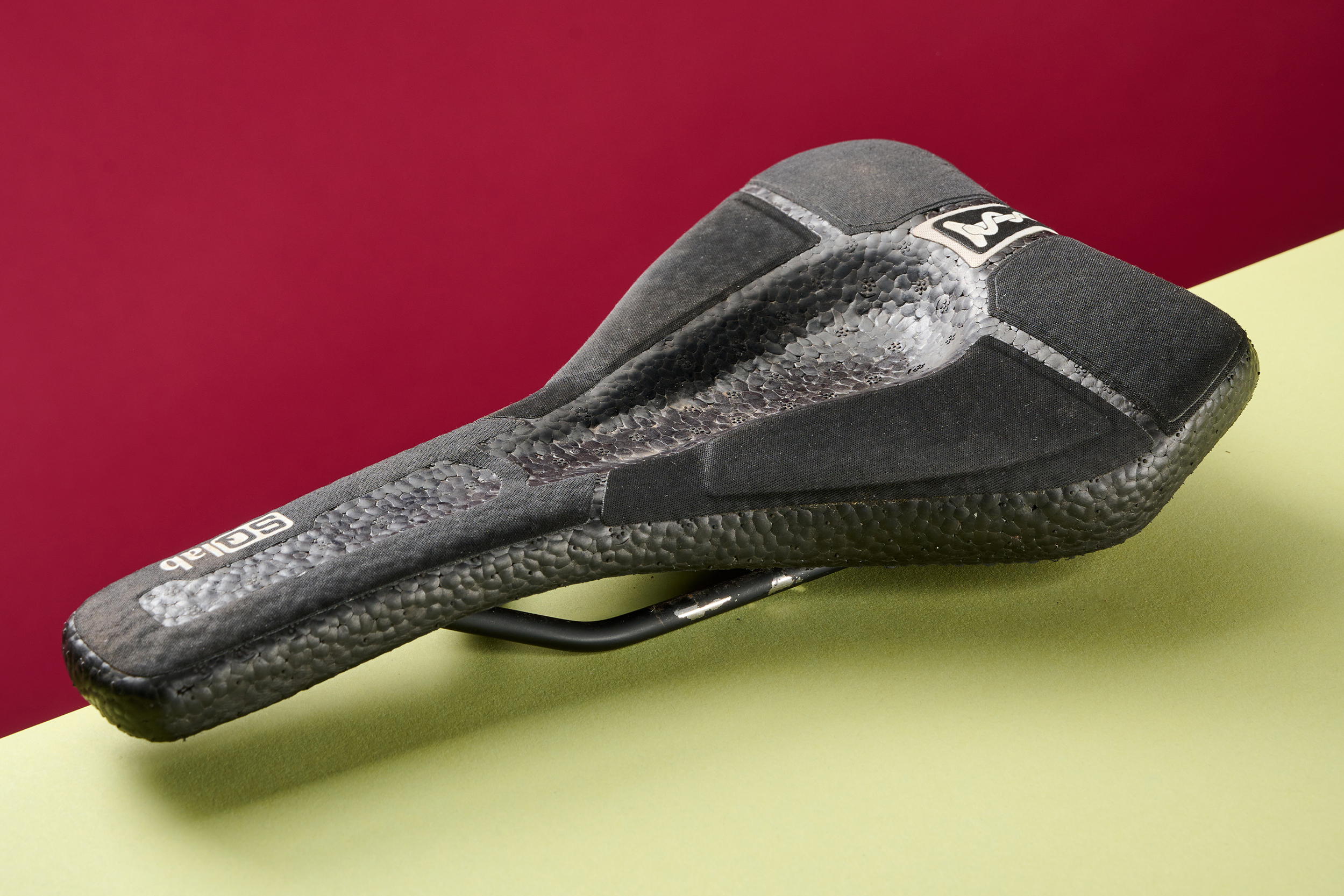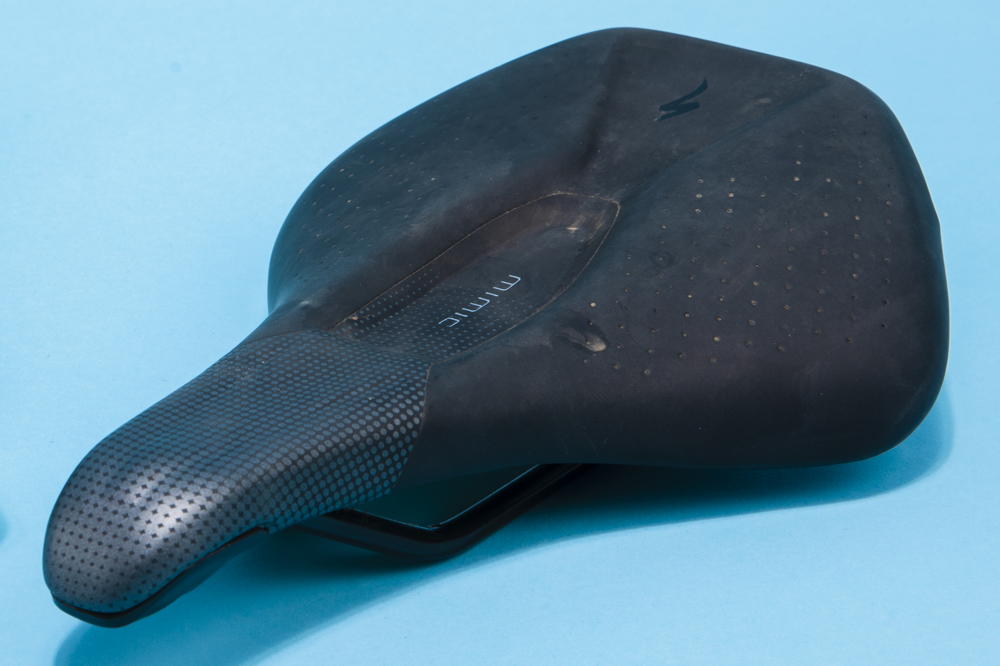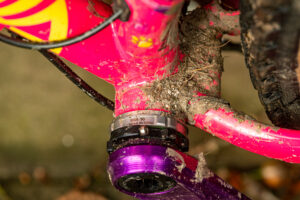Saddle choice can make or break your ride (and your rear), so choose wisely with our top women's saddles as rated by our expert testers
Every body is different; physiologially, and in terms of the types of trails they ride, the bike they have, and their overall riding preferences, so finding a comfortable saddle can be a tricky business. The best mountain bike saddle for women won’t necessarily suit every woman. However, we’ve tested a whole load of different options to help narrow down the choice and help you find a a saddle that’s comfy, supportive, light, and fits within your budget, and it’s also worth taking at look at our best mountain bike saddle for a few more unisex options.
Saddles designed for women will often take into account the different anatomy of the female genetalia, provide support where required and alleviating pressure where rubbing or chaffing might occur. They’re available in a range of different widths, to suit different sit-bone widths, and we also break down some of the different things you might want to consider when purchasing one.
Since not all saddles will work for all women, if possible it’s worth trying a few before you buy – some brands offer demo saddles to borrow, or a replacement option if the one you buy doesn’t work for you.

1. Specialized Power Comp Mimic
Best women’s mountain bike saddle overall
Weight: 219g | Length: 240mm | Widths: 143/155/168mm | Rating: 10/10
Reasons to buy: Radical but effective, SWAT compatible for mounting spares, popular with both men and women
Reasons to avoid: Divisive – not universally loved, so do try before you buy, quirky looks
Specialized’s radical Power Comp saddle comes with Mimic technology, designed to mimic the body tissue it’s in contact with to provide the right support in the right places, minimsing pressure and maximising blood flow. With three sizes at 143mm, 155mm and 168mm there’s a great choice on offer to match any width of sit bones, and the wings offer plenty of flexibility without introducing a seasick feeling when pedalling on rough ground.
Up front, there’s no central cut-out as Specialized found this can cause pinching. Instead memory foam is used to create a hammock-effect. And the nose falls away at the tip to further reduce pressure and ensure that it doesn’t get caught on clothing when descending.The finish is good quality and subtle and Specialized has given it a practical edge with SWAT compatible mounts under your seat for mounting accessories.
Specialized boasted on the launch of the Mimic that ‘your vagina will thank you’ and, from where I’m sitting it was absolutely right. A great combination of aesthetics, durability, price and, above all, comfort.

Ergon SMC Sport Gel
2. Ergon SMC Sport Gel
Great all-rounder with conventional styling
Weight: 312g | Length: 265mm | Widths: 149/164mm | Rating: 9/10
Reasons to buy: Supportive and stable. Rear deck is good for pushing against on climbs. No pressure points
Reason to avoid: Heavy. Deep, thick padding raises saddle deck height and might not suit more dynamic riding
As the name suggests, Ergon prides itself on making components that interface perfectly with the human element. The SMC Sport Gel is a hefty unit with a large rear deck, thick padding and a chunky overall weight. We had to make sure we positioned the saddle perfectly on the rails to keep it from interfering with thighs while pedalling, but once set-up it held the pelvis in a great position and gave plenty of support for pushing against when grinding up a climb.
This range topping model has gel cushioning on top of orthopaedic comfort foam which runs across the entire contact area. We found this meant the sit bones were supported on nice soft material that didn’t feel too squishy thanks to the denser material beneath. Ergon offers two sizes, and some Ergon dealers have a machine to measure your sit bones if you’re unsure which width to choose. There’s also a rough calculator on the Ergon website to give you a rough idea of the ideal fit.
Even on all-day rides we experienced no pressure or soreness on labial tissue – the wide central cut-out and tapered channel seem to work exactly as intended. Our only gripe is the weight, but if saving a few grams is less important to you than all-day ride comfort, that won’t be a deal breaker.

Syncros Savona V 1.5 Cut Out
3. Syncros Savona V 1.5 Cut Out
Best for upright riding position
Weight: 240g | Length: 245mm | Widths: 145mm | Rating: 9/10
Reasons to buy: Supportive and stable. Rear deck is good for pushing against on climbs. No pressure points
Reasons to avoid: Heavy. Deep, thick padding raises saddle deck height and might not suit more dynamic riding
Syncros takes a slightly different approach to tailoring its saddles. Rather than offering different widths, it has a Savona designed to suit different riding positions: upright and stretched. The solutions are based on two factors: your flexibility through your pelvic and lumbar region, and pressure sensitivity around the labia. Choose the ‘R’ Regular range if you have average flexibility and sit in a more upright position, or the ‘V’ design if you sit in a low, sporty position. Further personalisation comes in the form of either a central channel or a full cutout depending on the level of pressure relief you need.
The Savona takes a pretty minimal approach to padding, particularly next to the Ergon. It gets an almost flat profile and a deep central cutout along the centre of the saddle. The medium length and medium width offered generous support and the nose never felt bulky or in the way. Syncros advertises the wings as 145mm in width, but the abrupt taper means they are more like 180mm at their broadest. However, they give ample support for the sit bones, and while the padding is quite spartan, the Savona proved to be a really comfortable perch.
On the underside, hidden under rubber Syncros detailing are screw mounts for a range of direct mount products, including a fender, saddle bag and Go Pro mount. A rubber cap means the holes won’t fill with mud if you choose not to make use of it. Overall it’s a classy bit of kit from the Syncros stable.
Read the full review of the Syncros Savona V 1.5 Cut Out saddle.

4. SQ Labs 60X Infinergy Ergowave saddle review
Most comfortable unisex saddle for mountain biking
Weight: 269g | Length: 245mm | Widths: 130, 140, 150, 160mm | Rating: 8/10
Reasons to buy: Very comfortable, secure perch, four width options, pressure relief channel
Reasons to avoid: High cost, poor rail finish, central channel can fill with mud
The saddle features hollow cro-mo rails and these are anchored in a T-shaped bridge, under which sits an elastomer. It has three tiers that extend from the rear to the front creating a sort of a natural wedge that stops you pushing too far back. To reduce pressure, the saddle is flat at the nose and also features a deep channel running mid to back.
Interestingly SQ Labs says it’s a true unisex design, so should suit male and female riders equally.
We had a couple of issues; the paint flaked off the rails on one ride, which is not good for a saddle costing nearly £145. If conditions were wet, the deep channel would fill with mud, causing us to float around on the surface. The patches on the surface have also got a little bit polished, which doesn’t help with traction.
This won’t win any awards for styling, but it’s supremely comfortable. Unfortunately we’ve had to peg it back a point due to the slightly high cost and poor rail finishing.
Read the full review of the SQ Labs 60X Infinergy Ergowave saddle

5. Specialized Bridge Comp with Mimic saddle
Best mountain bike saddle for all-round comfort and performance
Weight: 324g | Length: 262mm | Widths: 143, 155 and 168mm | Rating: 10/10
Reasons to buy: Available in 3 widths, pressure relief channel, density-mapped padding, SWAT-compatible
Reasons to avoid: Cover is glued not bonded
The Specialized Bridge Comp is easily the most comfortable and supportive unisex saddle we’ve tested. This is the top model in the Bridge saddle range from Specialized, and while it might be pricy in our opinion it’s worth it.
Mimic is a saddle construction technique Specialized used where different density foam is used to increase comfort and support, and was originally designed for women’s saddles then rolled out when it proved popular with all riders. When we sat on the Bridge it was instantly comfortable. We didn’t have to muck about with the angle or position of the saddle on the rails.
The Bridge also has a stress relieving centre channel, but with really smooth transitions between the high and low points. It also doesn’t extend all the way forward, so the padding on the nose remains consistent.
The only real sticking point with this saddle is that the cover is only glued on. We’ve not had any issue with it coming away, but there’s already a bit of wear on the edge. That said, it’s easily the most comfortable and supportive saddle here and winner of our best saddle title.
The Comp uses a standard cro-mo rail, and the features two SWAT compatible mounts moulded into the rear. This allows you to bolt on the Mountain Bandit, which is a little tube/CO2/tool holder.
Read the full review of the Specialized Bridge Comp with Mimic saddle
How we tested
All saddles have been ridden extensively on a variety of different terrain and durations, tested for comfort and performance while climbing, on long pedally trails, and mixed terrain where the rider is in and out of the saddle frequently.
Considerations such as width options, cost, durability, comfort, plus features such as cut-outs or pressure relief channels were also included.
What to look out for in the best women’s mountain bike saddles
Before the widespread adoption of the dropper post, the saddle was a relatively static component, but these days your saddle moves up and down numerous times every ride and, depending on whether you’re rolling along the flat, cruising up a gradual climb, or tackling a steep ascent your weight can be positioned over different parts of it. This means gauging comfort is a little bit harder, especially since we don’t all have the same width sit bones or, obviously, anatomy.
The saddle is also used to control the bike, especially when it’s dropped down and you’re descending. Introduce electric mountain bikes into the mix, which encourage you to sit down and pedal more of the time, and you have a component that subtly switches roles multiple times during a ride.
What’s the difference between a women’s and men’s saddle?
Anatomical differences between make and female riders mean saddles are sometimes, but not always, designed with specific needs in mind.
For example, many women’s saddles have central channels and/or dropped or truncated noses intended to relieve pressure on soft tissue and maintain blood flow to sensitive areas. Other popular design details include clipped wings to prevent thigh chafing, and many saddles offer two or more widths to suit different sit bone widths.
Despite all the research and development into improving women’s saddles, it remains a very personal choice, and a saddle loved by some women might be hated by others. And there are plenty of women who find a men’s saddle perfectly comfortable, and men who get on well with women’s saddles.
It also turns out that some of the innovation in women’s saddle development – such as Specialized’s Mimic technology, or truncated nose shapes – also proved very popular with male riders. So now the Specialized Power Mimic saddle is marketed as a unisex saddle, as in fact is the entirety of the Specialized saddle range.
In other words, saddle choice is an incredibly personal thing, and so the best way to find out what works for you is to try a selection out.
What are the main features of the best women’s mountain bike saddles?
If you’re looking for a great saddle, there are a few elements to consider which will influence your decision. Cost is of course one of them, and most of the physical elements below will be affected by that; for example, lighter saddles made from lightweight-but-strong materials like carbon will price up more expensive.
1. Cost
Saddles can range in price from £30/$40 to well over £100/£150. At the higher end, you’re paying for things like lighter and stronger rails, more durable padding and cover, or additional features like the ability to use compatible products like lights or bags if you want.
The good news is that most brands will have a saddle shape available at a range of price-points, so if you find a shape that suits you, you don’t necessarily have to sell your bike to afford the saddle.
2. Cut-out or channel
Many women’s saddles will feature either a cut-out – essentially a hole along the centre of the saddle, running fore to aft – or a channel. Both of these are designed to relieve pressure on the tissue of the vulva and labia.
The downside to cut-outs is that they also don’t prevent mud, water and cold air flowing up from the wheels to your nether regions. And some women find that cut-outs and pressure relief channels can in fact end up increasing pressure to the tissue that rests on the edge of these areas. For other women, these features are a must-have.
3. Cover
This is often a synthetic leather, which is hard-wearing, breathable and long lasting. To add greater abrasion resistance and grip, Kevlar sections are often used at high-wear areas such as the corners and rear of the saddle.
4. Padding
Underneath the cover is a layer of EVA foam. It’s lightweight and has good shock absorption properties. On some saddles you also get a supplementary gel or elastomer pad under the forward areas. This reduces stress on delicate parts and improves overall comfort.
5. Width
Most manufacturers now produce saddles in different widths to match a narrower range of sit bones. However, this is not the only thing that affects comfort – the overall shape, length and even the angle you’re sitting at, all play a part. Getting the correct width is a good starting point, but don’t be afraid to try a narrower or wider saddle (you may have to switch brands) if the one you have isn’t particularly comfortable.
6. Height
Saddles have different heights between the rails and the seat, and low-profile saddles let you run longer dropper posts. Some low-profile saddles are also cut away at the tail to provide extra tyre clearance when the saddle is dropped – useful for long travel 29ers with slack seat angles.
7. Base
This is made from an injection moulded plastic. To add comfort and alleviate pressure some manufacturers cut holes or channels into the base. Offsetting the rails on the base, or mounting them on small elastomer bumpers, also introduces greater flexibility and comfort.
8. Rails
The cheapest saddles have solid steel rails and they obviously weigh the most, but you can save weight with hollow steel, titanium or composite rails. Be aware that manufacturers do mix other elements into the steel and give it a flashy name, but essentially, it’s the same stuff. Regardless of material, most saddles have 7mm rails and will fit most seatposts on the market, it’s one of the few industry standards that hasn’t been mucked about with. But, as ever, there are a few exceptions to consider so don’t forget to double check.
How do I know what size women’s bike saddle I need?
Saddle size is determined by the width of your sit bones. These are the bony protuberaces and the base of the pelvis and are, quite litterally, the load-bearing points that your body rests on while sitting.
The thinking is that for a saddle to be comfortable, both sit bones should be firmly supported on the saddle. To narrow, and you can end up riding half-off the saddle which can cause chafing or even knee issues, and your body compensates for the poor support platform. To wide, and you’ve got too much saddle interfering with your upper legs as you ride, which can cause chaffing here.
Most bike shops will have a way of measuring your sit bone width that’s thankfully not as invasive as you might think. It usually takes the form of a gel pad which you sit on; the centre of indentations under each cheek indicate the location of the sit bone, and it’s the distance between these that gives the sit bone width. To find the right saddle, find one with a width that corresponds as closely as possible to that measured sit bone width.
How can I test women’s mountain bike saddles?
Some brands, bike shops and bike fitters offer saddle demos that allow you to go off and ride with the saddle for a few hours to get a better idea of how it feels. It’s usually possible to tell pretty quickly whether a saddle is heaven or hell. Some saddle companies will also have stands at events like festivals and races for the same reason, and will be on hand to provide advice.
Another option is a saddle library. Often run by local bike cooperatives and some bike shops, these are literally a library of saddles where you can check one out at a time to test ride it, and work out what works for you.

















